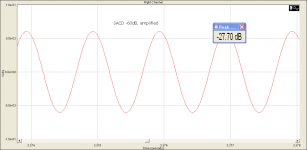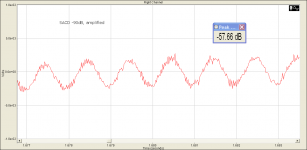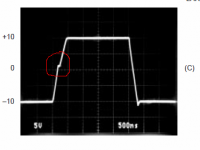Chris, I completely agree with your -60Vu comment. The information that separates quality analog from digital seems to reside there, for example. I KNOW that analog tape recordings have lots of third harmonic distortion, yet it is not so bad as the numbers would imply, AND that the low levels are virtually distortionless, by comparison. That does not mean that analog tape recording is perfect, it obviously is not, but it can be 'magic' in the way it can convey the essence of a human voice, etc.
Again, the test is not very difficult. We can take music signal recorded at -60dB from vinyl, tape, CD, 24/96 and SACD, amplify it to 0dB level and compare the results. Many have probably done that, and me as well. 24/96 and SACD are the winners, as expected. From vinyl, we get groove hum, from tape we get hiss.
IMO it is the LIMITED resolution of details that might be the main the reason why vinyl and tape are preferred. These signal sources require LESS quality of amplifiers and speakers.
Last edited:
(apply the 1V to the input almost instantly, 1nS for example, and while settling is not completed, we apply 1uV to the input).
Sorry, I am afraid you do not know what you speak about. Have you ever tried to apply 1V signal of 1ns duration to audio? You will even not be able to transfer it through cable to input of audio device, and if yes (horribly distorted in amplitude and shape), it will not pass through.
You are correct, Vlad, it is the difference between STATIC and DYNAMIC distortion. They are virtually always different, as previously shown by Matti Otala's (and my) paper on TIM in 1976. If you have a copy of our paper, just look at the comparison between using a TRIANGLE and a SQUARE wave input on an op amp. This makes it clear. Of course, the repeating nature of the source waveform is still not equivalent to music. We must go farther to develop interesting tests that bring the differences out, beyond what we measure today.
Sorry, I am afraid you do not know what you speak about. Have you ever tried to apply 1V signal of 1ns duration to audio? You will even not be able to transfer it through cable to input of audio device, and if yes (horribly distorted in amplitude and shape), it will not pass through.
PMA, I has indicated this non-realistic case only for illustrating an idea, excuse me for the confusion caused by this. Of course, this example is a big exaggeration, and may be not the best one.
In this, I am trying to attract attention to "after-action" issues, everything contributes to settling processes, caps, electromagnetic interactions, NFB (error-signal copies circulation), as a reaction to a single pulse. And this pushes us to thinking about "dynamic" transfer function and limits in information transfer rate.
Last edited:
No problem, I keep my opinions.
I would like to see measurements of 1V/1ns impulse followed by 1uV signal.
And I would like to hear -60dB vinyl and tape output amplified and compared to -60dB SACD output amplified.
I have made enough impulse measurements in my career and I have compared low level signals of different sound sources. I do publish measurement results here quite often, though many seem to speak only and express their guesses.
I would like to see measurements of 1V/1ns impulse followed by 1uV signal.
And I would like to hear -60dB vinyl and tape output amplified and compared to -60dB SACD output amplified.
I have made enough impulse measurements in my career and I have compared low level signals of different sound sources. I do publish measurement results here quite often, though many seem to speak only and express their guesses.
Vladimir,
This type of behaviour has been called "Fuzzy Distortion" by some in the circle around Malcolm Hawkesford (the term has a derivation from "fuzzy logic" I believe and not the furry/fuzzy 'scope traces BTW).
It is present in many types of looped feedback systems that measure quite well normally. They may include anything, I have experienced this phenomena with control loops in both industrial and military applications. It presented itself as a hysteresis that dependent on the signal history and could result in rather drastic failures of such systems.
In audio we encounter them routinely in looped feedback amplifiers and other looped feedback systems such as Delta Sigma noise-shaping and the related processes in Class D Amplifiers.
Plus, the issue is additionally that the "wrong" reaction to the small signal is not reliably predicted by traditional non-linearity measurements (HD and IMD) and so such measurements are often exemplary.
I found that classic noise loading testing can reveal what I believe to be the results of this behaviour where the distortion results of noise load testing are dramatically higher than what is revealed by classic HD testing.
Ciao T
We should think about measurements at transient conditions (apply the 1V to the input almost instantly, 1nS for example, and while settling is not completed, we apply 1uV to the input). The responce to 1uV in such conditions will not be the same as without 1V applied. Etc.
This type of behaviour has been called "Fuzzy Distortion" by some in the circle around Malcolm Hawkesford (the term has a derivation from "fuzzy logic" I believe and not the furry/fuzzy 'scope traces BTW).
It is present in many types of looped feedback systems that measure quite well normally. They may include anything, I have experienced this phenomena with control loops in both industrial and military applications. It presented itself as a hysteresis that dependent on the signal history and could result in rather drastic failures of such systems.
In audio we encounter them routinely in looped feedback amplifiers and other looped feedback systems such as Delta Sigma noise-shaping and the related processes in Class D Amplifiers.
Plus, the issue is additionally that the "wrong" reaction to the small signal is not reliably predicted by traditional non-linearity measurements (HD and IMD) and so such measurements are often exemplary.
I found that classic noise loading testing can reveal what I believe to be the results of this behaviour where the distortion results of noise load testing are dramatically higher than what is revealed by classic HD testing.
Ciao T
I like to be clear and bring results.
Just now I have prepared 2 measurements. SACD output at -60dB and -90dB. Amplified by my line preamp + power amplifer and measured at power amplifier output terminals. The result is attached. I encourage anyone who speaks about low levels from tape or vinyl to show the same, especially -90dB would be of my great interest. The results I am showing are 24bit/48kHz digitized and the smaller signal reflects A/D imperfections.
Just now I have prepared 2 measurements. SACD output at -60dB and -90dB. Amplified by my line preamp + power amplifer and measured at power amplifier output terminals. The result is attached. I encourage anyone who speaks about low levels from tape or vinyl to show the same, especially -90dB would be of my great interest. The results I am showing are 24bit/48kHz digitized and the smaller signal reflects A/D imperfections.
Attachments
Last edited:
Pavel,
The AD is likely also Delta Sigma. What would you expect to see from this?
Why don't you apply noise load testing instead and use analogue measurements?
As a hint, all DS based AD's [and DA's] I tried have shown themselves essentially useless in noise-load testing, you never get decent notch depth with a loopback setup!
On the other hand pure analog systems seem to manage okay.
Ciao T
The results I am showing are 24bit/48kHz digitized and the smaller signal reflects A/D imperfections.
The AD is likely also Delta Sigma. What would you expect to see from this?
Why don't you apply noise load testing instead and use analogue measurements?
As a hint, all DS based AD's [and DA's] I tried have shown themselves essentially useless in noise-load testing, you never get decent notch depth with a loopback setup!
On the other hand pure analog systems seem to manage okay.
Ciao T
Pavel,
The AD is likely also Delta Sigma. What would you expect to see from this?
Ciao T
Thorsten, the A/D is of no importance now. Even with non-ideal A/D we can see that SACD has no problem with -60dB (even spectrum is clean, no harmonic frequencies) and still has enough resolution at -90dB. The vinyl and tape will have NOTHING at -90dB (except for noise and hum) and something very poor at -60dB. The low level is no answer to me. In fact, both vinyl and tape are unable to reach SACD resolution. In case you listen to good recordings of orchestral classical music, you MUST be aware of this fact.
I have attached the non-averaged non-FFT signals, and non-filtered samples, for the reason I know you do not like averaging
Regards,
The issue with fuzzy distortions is usually considered for power amps, with their typically multistage and deep GNFB approach.
I would like to express my deep respect to PMA, as to a genuine professional. I am a DIY person only. But what can I say after 10 years of DIY, is that most professionals are mind-limited by the mainstream points of view, and I have learned almost nothing useful from professionals, at various forums, except for few papers by almost unpublic persons, like Arne Waagbo (a friend of Erno Borbeley) and from John Curl and Ed Simon (during the last year).
I am not biased by any interests other than getting of good sound, and only would like to repeat again - there is ALMOST NO SENSE to continue researches with periodic signals. Excuse me for being a bit unpolite.
Being led by almost intuition and some non-mainstream ideas, I have managed to get sound, that can justify all the years spent for this.
I would like to express my deep respect to PMA, as to a genuine professional. I am a DIY person only. But what can I say after 10 years of DIY, is that most professionals are mind-limited by the mainstream points of view, and I have learned almost nothing useful from professionals, at various forums, except for few papers by almost unpublic persons, like Arne Waagbo (a friend of Erno Borbeley) and from John Curl and Ed Simon (during the last year).
I am not biased by any interests other than getting of good sound, and only would like to repeat again - there is ALMOST NO SENSE to continue researches with periodic signals. Excuse me for being a bit unpolite.
Being led by almost intuition and some non-mainstream ideas, I have managed to get sound, that can justify all the years spent for this.
Vladimir, the point is that we should find the right and correct reasons. The lack of details at -60dB and possible tape higher cleanliness at -60dB level has been proven wrong. We have to concentrate to different issues
That is completely OK with me, the -60dB was not my point.
I could share the following practical observation, a different one. I have an analog kind signal generator, which gives a bit non-perfect square-wave test signal (there is a small and very short time overshoot (spike) at the front edge of the signal). Although a periodic signal, but some use can be extracted.
Usually stable and fast amps ignore this spike, they react by forming sharp front edge that smoothly approach the upper steady-state level.
My last power amp with jFET output stage, the best sounding one, shows at the output square wave some single small overshoot bump, a bit wider than the original spike, without any ringing after on, but the amp does not ignor this spike, it is able to react on it, in spite that it is close to a "mad" situation caused to amp by the sharp front edge.
This is not -60dB situation, but such specific features of an amp depend on many things, not reflected in simulations, including internal EMI and real properties of NFB.
I interpret this as a characterisation of fuzzy distortions of an amp. If the small extra bump is not shown by the amp, hence some signal information, in the "digital" sence (yes bump - no bump) has been lost. Further, I suppose that in a complex musical signal we can also find cases when low-level bumps are lost at the output. And this is sensible to human's hearing.
Last edited:
Interesting; Strong resemblance to Bud's "ground control" thingies, but with a completely different explanation as to how they (allegedly) work.How open are you to radical ideas? This is a real test of the open mind: Walker Audio Announces Release of All-New Eliminator Directional Antennae | AVguide
I could share the following practical observation, a different one. I have an analog kind signal generator, which gives a bit non-perfect square-wave test signal (there is a small and very short time overshoot (spike) at the front edge of the signal). Although a periodic signal, but some use can be extracted.
Usually stable and fast amps ignore this spike, they react by forming sharp front edge that smoothly approach the upper steady-state level.
My last power amp with jFET output stage, the best sounding one, shows at the output square wave some single small overshoot bump, a bit wider than the original spike, without any ringing after on, but the amp does not ignor this spike, it is able to react on it, in spite that it is close to a "mad" situation caused to amp by the sharp front edge.
Have you compared time response (step response) of the amplifiers you have tested? Do they have same rise time of transient response? At any voltage level? Is any of them slew rate limited? These should be the first questions you should concentrate on. In case that the amplifiers under comparison have same "speed" (rise time, fall time and slew rate), then we may have an issue
Vladimir,
do you speak about step spike like this? How "long" is it?
I speak about small spike on the top left corner of square wave, like an overshoot of signal generator schematics, it is hardly visible at scope's screen vertical spike (just as a short piece of vertical line), the remaining square wave is perfect. One usually does not notice such spikes without enough attention to it.
If to speak about 20kHz square wave, the spike duration (settling time of the generator) is very short, since it looks just a piece of line.
I presume that it is a good (of course a bit exaggerated and too tuff) test situation for dynamic properties of an amp, in order to judge, does it become "insane" during fast transients and is it able to react on small signals within settling period.
Last edited:
I understand, maybe if you changed time base settings to a faster one, you could read the length of the "corner" overshoot. Based on the fact it is a 20kHz square, you are probably at 5us/div time base setting. The overshoot may be as short as 100ns or less, and many audio gear would not transfer it. The question is if it might be audible, I really do not think so, as it would reflect at MHz's in frequency domain.
- Status
- Not open for further replies.
- Home
- Member Areas
- The Lounge
- John Curl's Blowtorch preamplifier part II


